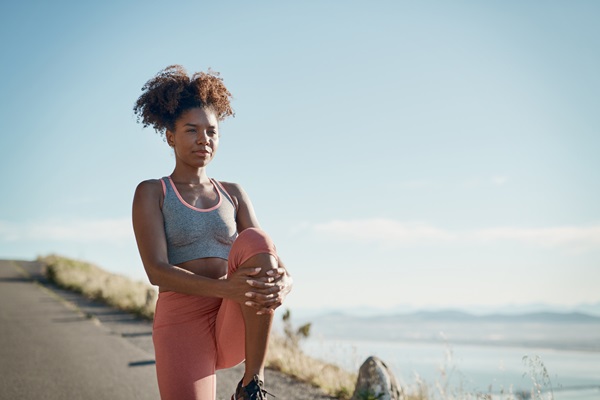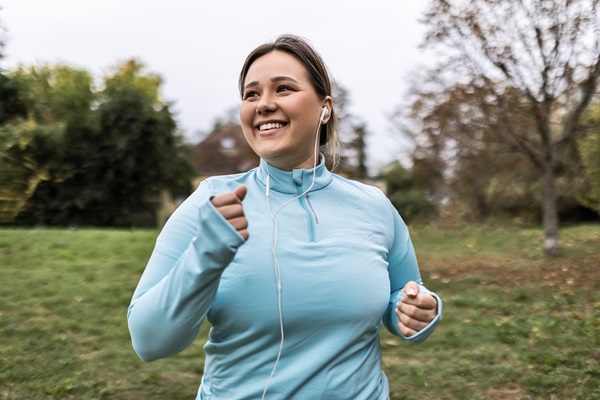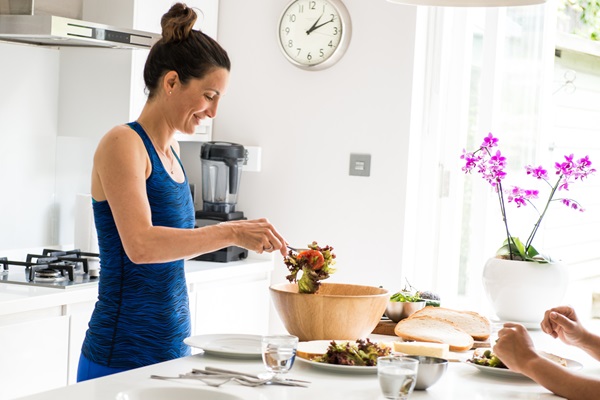-
Have you ever caught sight of yourself in the gym mirror while running or jumping and noticed the bounce? That uncomfortable reminder that your sports bra isn’t quite up to the task. You’re not alone. Research from Breast Research Australia has found that a high percentage of female athletes are wearing bras that:
- provide insufficient breast support, relative to their age, breast size and sport
- don’t actually fit.
The impact can go well beyond annoyance. Poor support can make exercise painful, uncomfortable or even embarrassing, discouraging women from staying active or cutting their sessions short. It’s a problem Professor Deirdre McGhee, sports physiotherapist and Director of Breast Research Australia at the University of Wollongong, has spent decades tackling.
When it comes to buying a new bra, Professor McGhee explains that many adolescent and adult females choose to fit themselves, rather than seeking a professional fitting. To address this, McGhee developed the Sports Bra Tool to help educate women on how to choose bras with high support design features, in the correct size. “It’s about empowering women to make informed choices,” explains McGhee. “Once they know what to look for, they can choose the bra design and fit that’s right for them and demand better bras.”
Why the right sports bra matters
Breasts are soft structures made up of fat, fibrous and glandular tissue, supported only by the overlying skin and their fibrous attachment to the chest wall muscles. During high-impact exercise, such as running or jumping, they can move significantly. McGhee’s biomechanical research has measured breast movement anywhere from 4 centimetres to as much as 17 centimetres, with approximately 10,000 bounces in just one hour of running. That’s why breasts need additional support from a supportive, correctly fitted sports bra,” McGhee says. “If your breasts aren’t supported sufficiently, it affects your posture, shoulder mobility and even running efficiency.” But the issue goes beyond performance. “Excessive breast movement is a barrier to physical activity, particularly in adolescents and women with larger breasts,” McGhee notes. In other words, the wrong bra doesn’t just ruin a run, it can sideline women and girls from sport altogether.
Why fit often fails
“Mothers don’t have the information, so they can’t teach their daughters,” says McGhee. “And bra fitting has traditionally been something done to you, rather than something you learn yourself.”
Most women, McGhee explains, don’t use professional bra fitters, instead, they fit themselves when purchasing a new bra. With so many buying online or in stores without trained fitters, education on how to choose a supportive bra design, in the correct size, that provides the level of breast support each women needs considering her breast size, age and sport is essential.
The bra sizing system used by the bra manufacturing industry also makes it challenging for women to fit themselves correctly, explains McGhee.
“Bra manufacturers use different cup moulds and size systems, so a woman can be one size in one brand and a different size in another. This lack of standardisation makes it challenging for women to find the right fit, particularly because bras are close-fitting garments. For adequate breast support, women need the correct bra fit and a supportive bra design. The most supportive bra won’t do its job if it’s the wrong size, just like a great pair of running shoes that don’t fit your feet.
Because of the bra size challenge, many women settle for a bra that “sort of works” and continue buying the same bra, even as their body changes.
The three types of sports bras
Finding the right sports bra shouldn’t require a PhD. Luckily, Professor Deirdre McGhee has done the heavy lifting for us and breaks it down into three simple categories.
1. Encapsulation bras
Ideal for larger breasts, each breast is supported in a separate cup and a firm under band offers better lift and support. “This style of bra supports your breasts by lifting them up, therefore if your breasts aren’t lifted, it’s not working,” she says.
2. Compression bras (crop tops)
Better for smaller and medium sized breasts. This style of bra supports your breasts by compressing them against your chest wall, therefore if they don’t feel compressed, it’s not working.”
3. Combination (hybrid) bras
A mix of both, looks like a crop top from the front but has internal cups and adjustable straps for extra lift and compression. This style provides more adjustability for sizing and more support than a crop top design, suiting women with small to large breasts. “This style of bra supports your breasts by lifting and compressing them against your chest wall, therefore if they don’t feel compressed and lifted, it’s not working.”
In general, if you’re smaller busted, any of these designs may suffice. But for larger breasted women, especially those with an E cup or above, McGhee recommends layering two bras for adequate support during high impact sports like running or football. “As your breast size increases, and as the breast movement in your sport increases, you need more support,” she says.
What to consider when shopping for a new sports bra
Wondering if the bra you’re trying on is pulling its weight? Here are a few things to consider.
Band
Fit: It should be firm but comfortable and stay in place without riding up or wrinkling. Lift your arms overhead, if the band moves or rides up, it’s too loose. Remember to start with the loosest hook, so you can tighten your bra as it naturally stretches over time.
Design: Strong elastic material.
Cups
Fit: Ensure there are no visible gaps or wrinkles in the fabric or breast tissue bulging over the side or font of the bra cup.
Design: High neckline so the bra cup fully contains each breast to limit excessive movement.
Straps
Fit: Should be firm but comfortable and stay in place, not digging into your shoulders.
Design: Wider, padded straps help distribute weight. Straps should be adjustable so you can find your sweet spot between too tight and too loose. Experiment with vertical straps or cross-back to see which feels best for you.
Material
Aim for a blend of stretchy and firm materials so your breasts are supported but not painfully compressed. Breathable and moisture wicking fabrics will also help keep you dry and comfortable.
“Women need to stop putting up with bras that do not fit correctly and that are uncomfortable to wear,” says McGhee firmly. “If you buy a bra online and it doesn’t fit, send it back. If you try on a bra in a retailer and it doesn’t fit correctly and is uncomfortable to wear, do not buy it”. Poorly supported breasts can cause pain and interfere with performance. “Similar to endometriosis,” McGhee notes. “Women put up with breast pain and uncomfortable bras because we don’t talk about them. But you don’t need to suffer, there are solutions”.
The power of the perfect fit
A well-fitted sports bra isn’t just activewear, it is essential female-specific sporting equipment. Bra comfort, fit and support can be the difference between females staying active or dropping out of sport, and can negatively affect athletic performance.
“Women wear bras for 12 to 14 hours a day,” McGhee says. “They should be comfortable and supportive. Staying active is vital for women’s long-term health and quality of life, so finding the right fit needs to be more of a priority”. Think of your sports bra as essential kit, not an optional accessory. The right one won’t just minimise bounce, it will help you move better, feel stronger and stay in the game longer.
Where to get help?
The Sports Bra Tool created by Professor Deirdre McGhee and Emeritus Professor Julie Steele can help guide you through the process of finding the right sports bra. The tool is supported by the Australian Institute of Sport and aims to arm women of all ages and breast sizes with the knowledge they need to find adequate support for them and their lifestyles.
READ MORE: Don't let breast pain ruin your run or explore more women's health articles
The Medibank Better Health Research Hub has partnered with and provided funding towards La Trobe University’s TRAIL W project. Find out more here: MBHRH Research Projects and Partnerships | Medibank and Trail W – HerSport.
How to choose and fit the right sports bra


Earn up to $400 worth of rewards every year!^
Earn points for tracking your every day healthy actions such as eating, walking, stretching... and even sleeping.
^ Medibank Live Better Challenges & Goals Earning Policy: The participant of a Medibank Live Better Challenge or Goal may not receive Live Better points or may have their already credited Live Better points reversed in accordance with the Medibank Live Better terms and conditions. To earn Live Better points, the participant needs to properly complete 100% of the eligible Challenge according to the instructions. The number of Live Better points available for Medibank Live Better Challenges and Goals is subject to change without prior notice. The maximum number of Live Better points that each Medibank Live Better member can earn from successfully completing health and wellbeing Challenges, Goals or any Onboarding action in a calendar year is 40,000 Live Better points. To the extent of any inconsistency between this Policy and the Medibank Live Better terms and conditions, the terms and conditions will take precedence.
-
Don't let breast pain ruin your run
Breast discomfort is common for runners, but it doesn’t have to slow you down. Here’s how you can help manage it and stay focused on the road ahead.
-
Training? Expert tips to help you get your nutrition right
Top nutrition tips for women training for a run, race or sporting event, according to an expert.
-
How to keep your iron levels up as an active woman
Iron deficiency – and sometimes anaemia – can be a common problem for active women. Here’s how to help ensure you’re getting enough iron.


